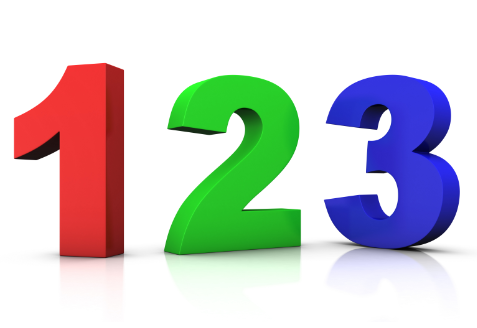Click on a concept below to try a sample question
Free, Printable 8th Grade Math
Worksheets for at-home practice

Download this informative guide to learn how to best support your eighth grader as they learn and master important eighth grade math concepts.
Download Now 25+ Free Practice Worksheet questionsClick on a concept below to try a sample question
A stated objective of Common Core State Standards (CCSS) is to standardize academic guidelines nationwide. In other words, what Eighth Graders learn in math in one state should be the same as what students of the same age are learning in another state. The curricula may vary between these two states, but the general concepts behind them are similar. This approach is intended to replace wildly differing guidelines among different states, thus eliminating (in theory) inconsistent test scores and other metrics that gauge student success.
An increased focus on math would seem to include a wider variety of topics and concepts being taught at every grade level, including Eighth Grade. However, CCSS actually calls for fewer topics at each grade level. The Common Core approach (which is clearly influenced by “Singapore Math”—an educational initiative that promotes mastery instead of memorization) goes against many state standards. Many states mandate a “mile-wide, inch-deep” curriculum in which children are taught so much in a relatively short time span, that they aren’t effectively becoming proficient in the concepts they truly need to understand to succeed at the next level. Hence, CCSS works to establish an incredibly thorough foundation not only for the math concepts in future grades, but also toward practical application for a lifetime.
For 8th Grade, Common Core’s focus is on helping students develop the skills required to formulate and reason about expressions and equations. Students learn to represent a situation with a linear equation and solve real-world problems using linear equations and systems of linear equations. Students also learn to model quantitative relationships in the real-world using functions, analyze two- and three-dimensional space and figures, and apply the Pythagorean Theorem.

Our Eighth Grade worksheets focus on three essential skills outlined by CCSS:
In Eighth Grade, some concepts require greater emphasis than others based on the depth of the cluster and the time that students take to master. Concepts learned in Eighth Grade are important to future mathematics and they cater to the demands of college and career readiness. Here are the three critical areas that Common Core brings to Grade 8 math:
 Expressions and Equations
Expressions and Equations
Eighth graders will use linear equations and systems of linear equations to represent the relationship between two quantities. They will learn to analyze and solve a variety of problems using equations. Students will use their understanding of the slope of a line to analyze situations and solve problems.
 Understanding Functions
Understanding Functions
Students will understand that a function is a rule that assigns to each input exactly one output. They will be able to translate among tabular, verbal, and graphical representations of functions and use them to analyze and solve real-world problems.
 Two- and Three-Dimensional Space and Figures
Two- and Three-Dimensional Space and Figures
Eighth graders will be able to understand how lines and angles behave under translations, rotations, reflections, and dilations. They will apply the concept of congruence and similarity to describe and analyze two-dimensional figures and solve problems. Students will show that the angle formed by a straight line is equal to the sum of the interior angles in a triangle. They will learn about the relationship between angles created when a transversal cuts parallel lines.
Students will also be able to prove the Pythagorean Theorem by decomposing a square in two different ways. They will apply the theorem to find lengths on a coordinate grid and analyze two-dimensional figures. Students will also solve problems on volume of cones, cylinders, and spheres.

Though they may have seem detailed, the four areas of focus presented in the previous section are more just starting points of what seventh-graders can expect during this crucial school year. From those areas, teachers and students will delve into more specific concepts that will prepare kids for eighth-grade math and beyond. The five topics presented here, taken directly from CCSS 4 itself, include some details on what kids will be taught in seventh grade.

 The Number System
The Number System
• Know that there are numbers that are not rational, and approximate them by rational numbers: Students will be able to differentiate between rational and irrational numbers. They will understand that every number has a decimal expansion. They will also understand that rational numbers are those with decimal expansions that terminate in 0s or eventually repeat. Students will be able to estimate the value of irrational expressions, compare irrational numbers, and locate them approximately on a number line. For example, by truncating the decimal expansion of √2, students will be able to show that √2 is between 1 and 2, then between 1.4 and 1.5, and explain how to continue on to get better approximations.
 Expressions and Equations
Expressions and Equations
• Work with radicals and integer exponents: Eighth graders will be able to apply the properties of integer exponents to generate equivalent numerical expressions. They will be able to use numbers expressed in the form of a single digit times a whole number power of 10 to estimate very large or very small quantities, and to express how many times as much one is than the other. Eighth graders will be able to perform operations with numbers expressed in scientific notation, including problems where both decimal and scientific notation are used. They will be able to choose appropriate units and interpret scientific notation that has been generated by technology.
• Understand the connections between proportional relationships, lines, and linear equations: Eighth graders will learn to graph proportional relationships and interpret the unit rate as the slope of the graph. They will be able to compare two different proportional relationships represented in different ways. For example, they will be able to translate between graphs, tables, and equations that represent the same relationship. Eighth graders will be able to use similar triangles to explain why the slope m is the same between any two distinct points on a non-vertical line in the coordinate plane. They will derive the equation y = mx for a line through the origin and the equation y = mx + b for a line intercepting the vertical axis at b.
• Analyze and solve linear equations and pairs of simultaneous linear equations: Eighth graders will be able to solve linear equations in one variable with one solution, infinitely many solutions, or no solutions. They will learn to solve linear equations with rational number coefficients, including equations whose solutions require expanding expressions using the distributive property and collecting like terms. They will also learn to interpret and solve pairs of simultaneous linear equations and understand that solutions to a system of two linear equations in two variables correspond to points of intersection of their graphs, because points of intersection satisfy both equations simultaneously. Eighth graders will learn to solve real-world and mathematical problems leading to two linear equations in two variables.


 Functions
Functions
• Define, evaluate, and compare functions: Eight graders will be able to understand that a function is a rule that assigns to each input exactly one output and the graph of a function is the set of ordered pairs consisting of an input and the corresponding output. Eighth graders will be able to compare properties, like the slope of two functions represented in different ways. For example, given a linear function represented by a table of values and a linear function represented by an algebraic expression, eighth graders will be able to determine which function has the greater rate of change.
• Use functions to model relationships between quantities: Eighth graders will be able to construct a function to model a linear relationship between two quantities. They will find the rate of change and initial value of the function from a description of a relationship or from two (x, y) values, including reading these from a table or from a graph. Eighth graders will Interpret the rate of change and initial value of a linear function in terms of the situation it models. They will analyze the graph of a linear or nonlinear function to identify where the function is increasing or decreasing.
 Geometry
Geometry
• Understand congruence and similarity using physical models, transparencies, or geometry software: In Grade 8, students will learn to verify experimentally the properties of rotations, reflections, and translations. They will learn that lines are taken to lines, and line segments to line segments of the same length, angles are taken to angles of the same measure, and parallel lines are taken to parallel lines. They will also understand that a two-dimensional figure is congruent to another if the second can be obtained from the first by a sequence of rotations, reflections, and translations. Eighth graders will be able to describe a sequence that exhibits the congruence or similarity between two figures. They will be able to describe the effect of dilations, translations, rotations, and reflections on two-dimensional figures using coordinates. Eighth graders will also learn to use informal arguments to establish facts about the angle sum and exterior angle of triangles, about the angles created when parallel lines are cut by a transversal, and the angle-angle criterion for similarity of triangles.
• Understand and apply the Pythagorean Theorem: Eighth graders will be able to explain a proof of the Pythagorean Theorem and its converse and apply the theorem to determine unknown side lengths in right triangles in real-world and mathematical problems in two and three dimensions.
• Solve real-world and mathematical problems involving volume of cylinders, cones and spheres: Eighth graders will learn the formulas for the volumes of cones, cylinders, and spheres and use them to solve real-world and mathematical problems.


 Statistics and Probability
Statistics and Probability
• Investigate patterns of association in bivariate data: Eighth graders will use the equation of a linear model to solve problems in the context of bivariate measurement data, interpreting the slope and intercept. For example, in a linear model for an experiment, students will interpret a slope of 1 cm/hr as meaning that an additional hour of sunlight each day is associated with an additional 1 cm in mature plant height. They will also construct and interpret scatter plots for bivariate measurement data to investigate patterns of association between two quantities, such as clustering, outliers, positive or negative association, linear association, and nonlinear association.. Eighth graders will be able to fit a straight line for a scatter plot and analyze the model fit by judging the closeness of the data points to the line. Eight graders will construct and interpret a two-way table summarizing data on two categorical variables collected from the same subjects. They will use relative frequencies calculated for two-way tables to describe possible association between the two variables. For example, collect data from students in your class on whether or not they solve puzzles everyday and whether or not they get good scores in math. Is there evidence that those who solve puzzles also tend to get good scores in math?
Some of parents’ trepidation with Common Core isn’t so much with the guidelines themselves, but with the testing now aligned with CCSS via local math curricula. Fortunately, CCSS does not have to be that stressful, for you or your eighth grader. Here are some tips to help your children succeed with Common Core math:

 Be informed; be involved
Be informed; be involved
If Common Core concerns you, intrigues you, or confuses you, don’t hesitate to learn as much about it—in your child’s classroom, at your kids’ school, and on a national level. Talk with teachers, principals, and other parents. Seek advice on how you can help your kids, and yourself, navigate CCSS math. If you want to take further action, become involved with PTA or other organizations and committees that deal with your school’s curriculum. The more you know, the more, ultimately, you can help your child.
 Live them some real-world math
Live them some real-world math
A basic tenet of Common Core is to apply math principles to real-world situations. Why not start now? Your eighth grader might struggle with understanding irrational numbers. Let your child know that irrational numbers like pi are just numbers that cannot be written as a ratio. Emphasize that irrational numbers are actually used in the real world to find the area and circumference of circular objects like a wheel, plate, and ring.
 Take time to learn what they are learning
Take time to learn what they are learning
Solve problems with your eighth grader. Your child will be motivated to learn when you show interest in tackling problems together. Take help from a tutor or online math learning platform to brainstorm strategies to break up a problem into smaller steps to solve them easily.
 Encourage them to practice
Encourage them to practice
You can help your eighth grader practice new concepts at home. You can use sticky notes to help your child memorize perfect squares upto 200. Each sticky note will have a number and its square root equivalent. For example 8 is √64. This exercise will help your child solve more complex equations with square roots.
 Embrace math
Embrace math
Many parents believe that math is a difficult subject to grasp. Research shows that a child’s math scores improve when parents embrace math and encourage their child to practice it in their everyday life. A child’s performance in math is adversely impacted when parents suffer from math anxiety and express that using negative statements about math.
 Seek more help if necessary
Seek more help if necessary
If your eighth grader is struggling with math, talk with his or her teacher first. You then might want to seek outside resources to help your child. Several online resources provide math help, including worksheets and sample tests that conform to Common Core standards. Tutoring might be an option you consider as well. Innovative iPad-based math programs have emerged that combine the personalized approach of a tutor with today’s technology. This revolutionary approach also may feature a curriculum based on Common Core, thus ensuring your child’s learning at home is aligned with what he or she is learning at school.
See up to a 90% Improvement in Math Scores Within 3 Months.
Start 7-Day Free Trial